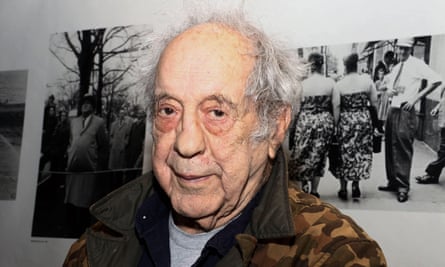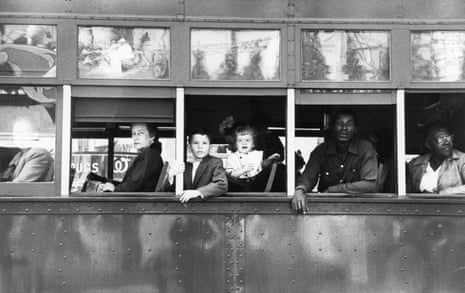Robert Frank, the American artist whose photographs captured the lives of everyday people and influenced a generation with his raw and evocative style, has died aged 94.
The Swiss-born photographer’s seminal book The Americans, which had an introduction from Jack Kerouac, beat generation author of On the Road, helped to change the direction of photography with its 83 pictures rejecting many conventions of the art form up to that point.

Shot on a Leica 35mm camera, the black-and-white images are considered Frank’s masterwork and focused on figures from the overlooked margins of American life – from teenage couples and factory workers to bikers. Dubbed the “Manet of the new photography” by the New Yorker critic Janet Malcolm, Frank was considered the father of “the snapshot aesthetic”, which captures a spontaneous moment taken on the fly.
Culled from a collection of around 28,000 pictures, The Americans would influence artists including Jeff Wall, Mary Ellen Mark and Ed Ruscha, who said seeing the book as a young man was “a stunning, ground-trembling experience” that inspired him to make his own art. “I was tired of romanticism,” Frank said of The Americans, “I wanted to present what I saw, pure and simple.”
That pursuit of purity and simplicity helped Frank find what Sean O’Hagan described as “the chasm between the American dream and the everyday reality”, with Kerouac saying in his introduction to the US edition of the book, which was released in 1959, that Frank had “sucked a sad poem out of America” with the 83 images.
Sarah Greenough, senior curator of photography at the National Gallery of Art in Washington – who compiled a major exhibition dedicated to Frank in 2008 – said the photographs revealed a people “who were plagued by racism”, “ill-served by their politicians”, and also rendered “increasingly numb by the rising culture of consumerism”. “But it’s also important to point out that he found new areas of beauty in those simple, overlooked corners of American life,” she added. “In diners, or on the street. He pioneered a whole new subject matter that we [now] define as icons: cars, jukeboxes, even the road itself.”
As well as Frank’s style challenging the rules of photography which had been solidified by the likes of Henri Cartier-Bresson, Frank was also set on challenging the American establishment. “My mother asked me, ‘Why do you always take pictures of poor people?’ Frank told the New York Times. “It wasn’t true, but my sympathies were with people who struggled. There was also my mistrust of people who made the rules.”
Frank’s style was widely credited as opening the door for other photographers such as Diane Arbus, whose work was exhibited at the hugely influential New Documents exhibition at MoMA in 1969 alongside at-the-time up-and-coming artists Lee Friedlander and Garry Winogrand.
In the 60s and 70s Frank would become a countercultural figure and establish himself as an avant-garde filmmaker. New York Times film critic Manohla Dargis called Frank “one of the most important and influential American independent filmmakers of the last half-century” and his short-form films featured Jack Kerouac, Allen Ginsberg and Alice Neel.
After being commissioned to take cover photography for Exile on Main Street, Frank went on to make Cocksucker Blues, a documentary about the Rolling Stones’ 1972 tour of America, which the band sued him for in order to prevent its release. Described as “an ambient Stones movie” it showed the band and groupies involved in drug taking and group sex. It was shelved in favour of another documentary of the 1972 tour, titled Ladies and Gentlemen: The Rolling Stones.
In the same year Frank released Lines of My Hand, a book which signalled the artist’s move to more autobiographical work that could also be seen in the 1988 film, Candy Mountain, a road movie directed with Rudy Wurlitzer.
Lou Reed, another musician, wrote about how much he admired Frank’s work in The Lines of My Hand, in 2004. “To wish for the crazy times one last time and freeze it in the memory of a camera is the least a great artist can do,” he wrote. “Robert Frank is a great democrat. We’re all in these photos. Paint dripping from a mirror like blood.”
There was tragedy in Frank’s personal life: first his daughter Andrea, was killed, aged 20, in a plane crash in Guatemala in 1974, and 20 years later his son Pablo took his own life in 1994 after suffering with schizophrenia. The artist June Leaf, his wife, survives him.
“The kind of photography I did is gone. It’s old,” Frank told the Guardian in 2004. “There’s no point in it any more for me, and I get no satisfaction from trying to do it. There are too many pictures now. It’s overwhelming.”

Comments (…)
Sign in or create your Guardian account to join the discussion